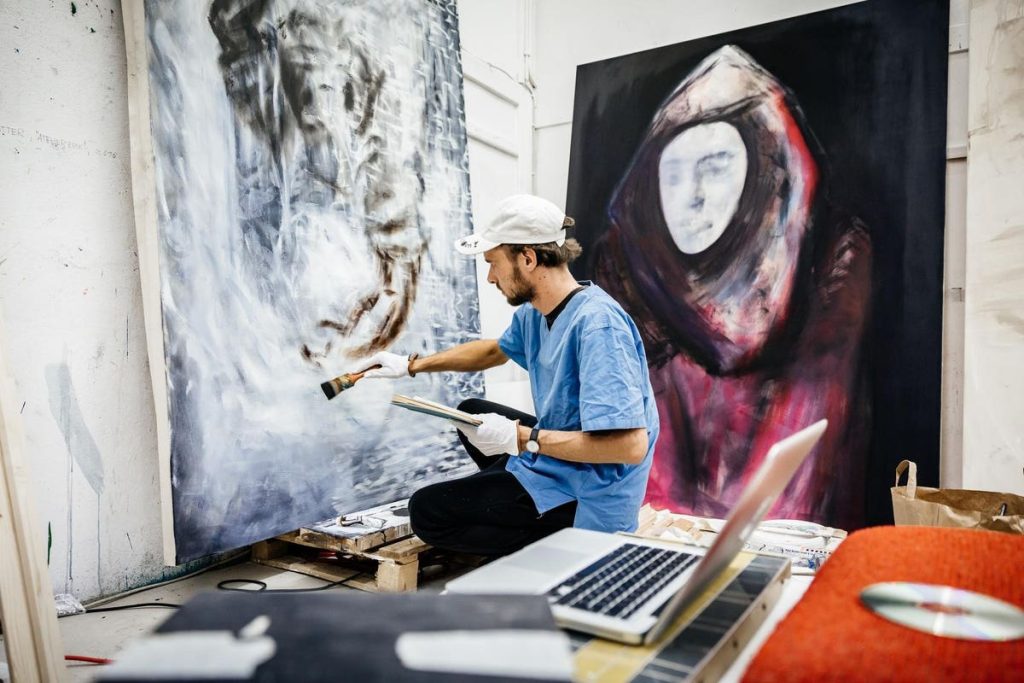Artists are the original freelancers. The history of professional artists appears to go way, way, back. In fact, according to Jewish tradition, Terah, the father of Abraham was a maker and seller of idols. It’s told that Abraham turned to monotheism as a result of experiences selling idols in his father’s shop.
The challenge facing most artists: building a reputation for their artworks, and making money during their lifetime.
Some have done extraordinarily well. Picasso died leaving an estate estimated at between $100 and 250 million dollars, the equivalent of more than $500 million today. Damien Hirst is worth $350 million dollars and viewed as the wealthiest living artist; number two is Jasper Johns with $210 million dollars.
But few artists are as financially successful as these amazing creators. According to Glassdoor, the average famous living artist has a total income below $50,000.
No surprise, most artists – then and now – have turned to side-gigs to pay the bills.
Lots have side gigs.
For example, the French painter Magritte turned to commercial art when his commissions weren’t sufficient. Henri Rousseau was a tax collector. Mark Rothko was a teacher and labor union organizer.
The side-gigs of famous and yet-to-be artists are a broad mix of activity. One source describes a range of 40 different well-used side-hustles, including roles like: house painter, landscape designer, and technical illustrator. Some are unexpected: Jeff Koons, among the best known artists, was a commodities broker.
Artists also team up to help each other:
“A celebrated sculptor, Serra teamed up with fellow New York City art buddies in the 1960s to found Low-Rate Movers. Employees included painter Chuck Close, monologist Spalding Grey, and the ever-industrious Philip Glass. They shared a van and mainly moved furniture. “It was a good job because none of us would work more than two or three days a week, so we had the remaining days to do our own work. “
Serra’s description points out an interesting fact discovered by Steve King of Emergent Research while doing market research for AMEX. The most successful artists, not always the “best” or “most creative” artists, but those able to build a reputation and make a strong living doing their art, seem to think about their career time in terms of three parts to a professional portfolio:
- Making time to create their art
- Time for making a living, typically through a side-gig
- Making time for building a brand and establishing a position among writers, gallerists, museum staff, journalists, and the public
Importantly, King found that the most successful artists among the top 100 well-known devoted as much time to their art business as they did to their art. He found a consistent 50:50 relationship (not counting side-gig time). But less financially successful artists (again, among the top 100 well-known) had a very different allowance. They spent only 20% of their art business time working to build the business, and the remainder creating their art.
Which raises a very interesting question. What do financially successful artists do to build their brand and manage their art business?
According to artnet, successful artists do so in a variety of way:
“Pablo Picasso understood the importance of creating a strong artistic (and colorful) image to intrigue his audience and add publicity to his outstanding art. Don’t be afraid to state your opinions or perceptions of the world and share your values, no matter how provocative and unconventional they may seem. Wrap your artistic persona into veils of controversy or mystery to provoke a public reaction.”
Here’s how artnews described Jeff Koon’s approach to building reputation:
“Koon is among the most prominent and controversial figures in the contemporary art world—and his fame hardly ends there. He’s also influenced the worlds of fashion and music through collaborations with Louis Vuitton, Lady Gaga, and others. Works by Koons, who is known worldwide for his lustrous sculptures often focused on themes from popular culture and notions of artifice, routinely sell for millions of dollars, and they can be found at the world’s top museums.” (Note. Koon also inspired the creative team of “Across the Spider-verse”)
The website skinnyartist describes the importance of an artist creating and directing attention to their work in “becoming famous”:
“Let’s face it, the fastest way to get attention is to scream: “Shock = Attention = Fame”.
“As you can see, our formula here is fairly simple. If you want to become famous, you’ve simply have to find a way to get people’s attention. Once you get people’s attention, you become famous.
“You see fame (unlike talent) is nothing more than capturing someone’s attention.”
Nevuefineartmarketing puts the branding challenge eloquently:
“There is much that is involved with designing an artist brand. You are an artistic entrepreneur and the CEO of your art business. One of your art marketing objectives is to create a brand with people recognizing your artwork. Unlike a corporate business, an artist’s brand is about an artist as an individual. An artist’s brand becomes personal and includes the individual’s ethics, philosophy, and beliefs. Many layers will create an artist’s brand, and each layer should be well thought out. Each layer will be a reflection of your business and, in turn, a reflection of you.”
Designhill also helps clarify the artist’s challenging in brand building:
“Today, branding is not only limited to products or companies. It has become an integral need for professionals as well. Whether you’re an entrepreneur or artist, you need to incorporate branding strategies to make a name in the industry.”
Keep four ideas in mind:
- First, the art market is growing. According to multiple surveys, the global art market estimated to be of over 67 billion U.S dollars in 2018 and is expanding at a rapid pace.
- Second, as Sotheby’s predicts, there are more art buyers than ever “As rapid technological transformation and the embrace of digital channels will remain ever present. The comprehensive set of digital tools clients can now access has not only broken down barriers to entry but reduced the need to view or physically handle works in person prior to purchasing. As a result, the average number of times that a work is seen will be exponentially multiplied.”
- Three, top artists are online: “It’s no secret that Instagram has made a noticeable impact upon the art market. The Museum of Modern Art and Sotheby’s are among the platform’s biggest art world players. Ai Weiwei, Jeff Koons, and Damien Hirst also have substantial followings ranging from 300,000 to 500,000. Describing one successful artist, Steve wrote in 2008 “Christine Hellmuth uses a mix of social media and online technologies to market her work. In addition to her website, she has a blog, an Etsy site, YouTube videos and a Yahoo group. She actively participates in arts and crafts community forums and chats. Her use of technology allows her to greatly broaden her potential market and she sells her work across the US and internationally.
- Fourth and last, sometimes it takes a village. Newfoundland has become a global haven for artists, and the artists there – some globally acknowledged like the late Christopher Pratt – have banded together in a variety of ways to support one another’s art and commercial opportunity. Read more about it here.
It just makes sense for talented artists, who have the ability to amaze and hypnotize patrons with their work, to have the marketing chops to create and close the sale.
Viva la Revolution!
Note. Thanks to Steve King and Emergent Research, for exceptional research and thought leadership. They’ve contributed so much to what we know about the experience and success of freelancers and how it might be improved.
Read the full article here









